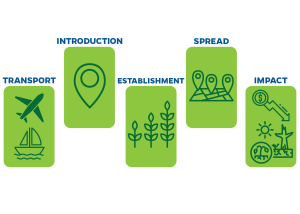This blog was written by Anelise Bullard, UF/IFAS CAIP communications intern.
Let’s talk about the process through which a nonnative plant species becomes invasive. As we mentioned in our previous blog, all invasive plants start out as nonnative. These nonnative plants move through five phases of the invasion process before they are considered invasive. These phases: 1) Transport, 2) Introduction, 3) Establishment, 4) Spread, and 5) Impact, break down what happens between introducing a species to an area to negatively impacting the environment and humans.

1. Transport
The nonnative plant species is moved from their native range. Transport is often the result of human influence from boat hulls, ballast water from large ships, and more.
2. Introduction
The nonnative species is brought to the new, introduced range. This occurs through either accidental or intentional introductions. Accidental introductions of nonnative plants through human activity are not intentional. Examples of accidental introductions include escape from confinement such as agricultural or aquacultural operations, movement of a commodity like timber, or plant ‘hitchhikers’ on vehicles and boats. Intentional introductions are deliberate actions by humans that place nonnative plants in a natural area, like introducing plants for erosion control.
3. Establishment
The nonnative plant forms a self-sustaining and reproducing population in the introduced range. Establishment happens without human intervention, meaning the nonnative plant species maintains this population on its own. Lag time is a small loophole that exists at this step. This means that some nonnative plants never become invasive because they stay at the introduction phase of the invasion process.
4. Spread
The nonnative population increases rapidly. With the drastic increase of nonnative individuals, the population begins to take over the introduced range. The nonnative plant population competes with native species for resources such as space, putting more pressure on them for survival.
5. Impact
The native community, environment, or human health is negatively impacted. Once the population begins harming or poses a threat to native species, the economy, or public health the nonnative population becomes an invasive species.
The invasion process is a helpful framework to illustrate where a nonnative plant population is in terms of becoming categorized as “invasive.” While it’s easy to say that we should control nonnative plant populations early in the process, it can be hard to decide when to act and what management strategy is best. As a species moves further through the invasion process, it becomes less likely that the species will be eradicated and more costly to control the population. By being proactive about invasive plant management, we are more likely to stop population growth before it becomes too large to control.
Helpful Resources
Lieurance, D., Kendig, A., and Romagosa, C. 2022. The Stages of Invasion: How Does a Nonnative Species Transition to an Invader? AskIFAS EDIS https://doi.org/10.32473/edis-AG463-2022
Prince, C. (2022, May 10). How Long Until a New Species Becomes Invasive? Let’s Talk Lag Phase! https://blogs.ifas.ufl.edu/caip/2022/05/10/how-long-until-a-new-species-becomes-invasive-lets-talk-about-the-lag-phase/
Questions or comments can be sent to the UF/IFAS CAIP communications manager at caip@ifas.ufl.edu. Follow UF/IFAS CAIP on Instagram.
Subscribe for more blogs like this one.
UF/IFAS Center for Aquatic and Invasive Plants. Turning Science Into Solutions.
Did you find this post helpful or interesting? Click the heart below!
 6
6
